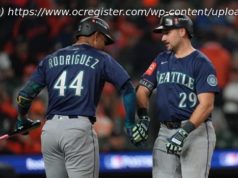Even with an isolationist in the White House and a U. S. team that flamed out, soccer’s explosion is here too
Anyone who has followed soccer in America for more than a few years is aware of multiple layers of irony this week. They begin with two contradictory but inarguable facts: One is that the world game has “made it” in America, to a degree that would have seemed inconceivable 15 or 20 years ago. Even our nation’s oft-derided professional league, Major League Soccer, which did nearly everything wrong for its first decade or so of existence, is now booming, with 23 teams (26 by 2020), lucrative TV and merchandising deals and a steadily improving standard of play.
The second is that the FIFA World Cup tournament, by far the planet’s biggest sporting event, kicked off this week in Russia — and the United States national team is absent for the first time since 1986. (At that time, most American players were not professionals, and the World Cup was such a curiosity in the U. S. that most matches weren’t even broadcast on English-language TV.) If those data points don’t seem to make sense, maybe it’s our country — and its bizarre, confused relationship to the rest of the world — that doesn’t make sense.
I mean, consider who we elected president, and how that’s going. Irrelevant? I don’t think so, and if you stick around I’ll explain why. But there’s more big soccer news: FIFA, the scandal-plagued federation that governs the international game, just awarded the 2026 World Cup tournament to the United States — as part of a three-way partnership with Canada and Mexico, the neighbors President Trump has done his level best to alienate.
Trump is of course claiming credit for this, because that’s his principal instrument. He apparently did play at least a supporting role in those negotiations, sending FIFA officials a letter — self-evidently not written by him, and quite likely not read by him — to reassure them that visitors from potentially-blacklisted Islamic countries would be welcome for the Cup. (Iran, to cite the obvious example, has a pretty good team in this year’s tournament.) Presumably the soccer overlords are aware that there’s no possible way Trump will still be president in 2026, unless he really does revoke the Constitution and cancel elections.
I would bet virtually anything that Donald Trump doesn’t understand the offside rule, and could not pick Argentina’s Lionel Messi or Portugal’s Cristiano Ronaldo — probably the two biggest stars playing in Russia this summer — out of a police lineup. Trump falls smack in the middle of the generation of white American men who have always viewed soccer as alien, incomprehensible and communistic, and therefore somehow unmanly. (Which is hilarious to anyone familiar with the misogynistic, racist and homophobic traditions of British and European footy.) Someone probably had to explain to him that there’s no worldwide tournament for American football because it’s a ludicrous and violent sport played in no other major nations.
But even if Trump is nowhere near the business genius and master dealmaker he pretends to be, he understands one thing well: Follow the money. Of course bringing the World Cup to North America is about money — the tournament is a major tourism cash cow, at least in a context where the stadiums and major infrastructure already exist — but so is the larger story of America’s evolving relationship with soccer, and soccer’s role in the global economy.
World soccer in the 21st century represents the opposite of everything Trump appears to stand for, in every respect but one. (That would of course be the money.) Indeed, the story of how soccer escaped its gritty, clannish, working-class roots and became an enormous global industry is a central cultural and economic parable of our time. That happened through essentially the same processes of globalization, commodification and “financialization” that have led to widespread resentment and right-wing backlash in much of Europe, as well as the election of You Know Who in the United States.
In bringing the World Cup to the U. S. — as part of a soccer-specific mini-NAFTA, no less — Trump not only risks pissing off Ann Coulter (who has literally argued that the rising popularity of soccer is a sign of America’s «moral decay»), he also accelerates and embraces the global trends he is supposedly trying to reverse. Vuvuzelas and hordes of Belgians in Cat-in-the-Hat costumes will not make America great again! If his supporters weren’t so mesmerized by his party tricks, they might perceive this as one of those tiny reveals where it becomes clear that Trump possesses no actual convictions beyond enriching the rich and abusing the poor, and that they’re going to get bulldozed all over again when he doesn’t need them anymore.
How big is world soccer? Hugely ginormous, which is another thing Americans don’t quite grasp. Although the World Cup will certainly be profitable, it comes with significant organizational costs, and only happens every four years. European club soccer, largely meaning the big-name professional teams in England, Germany, Italy and Spain, is where the real money is. That business was worth an estimated $27 billion in 2016, which is more than the top four North American pro sports leagues — plus golf, tennis and Formula 1 auto racing — all put together. Over the last 20 years or so, soccer has transformed itself into Big Soccer, going from a loose grouping of local teams and national leagues to a massive global enterprise fueled by an endless, borderless flow of capital, players, coaches, marketing, merchandising and broadcasting.
Soccer has become the most multiracial, multicultural and trans-national of all sports, though that was arguably a marketplace efficiency that was rebranded as a cultural value after the fact. Manchester United, the best-known team in the English Premier League, lists players from 14 different countries on its current roster. If we count all the young players United is developing in academies, reserve teams and foreign affiliates, the number would surely be much larger. Even that dramatically understates the racial and ethnic mélange of professional soccer: As Europe has become a more heterogeneous and immigrant-rich society, many of the continent’s best young players have roots elsewhere. It’s no longer even noteworthy that roughly half the players on the English national team are black, or that most of the surnames on the French national team suggest Arab or African ancestry.
Perhaps more to the point, with the right cable or streaming connection, you can watch every Manchester United match live — along with every Real Madrid match and every Bayern Munich match — wherever you happen to be in the world: Oklahoma or Vietnam or at the pub down the road from the stadium. Two or three decades ago most Americans had never even heard of those teams, let alone watched them play or developed opinions on whether their new superstar striker from Ghana was actually crap. Today you’re liable to encounter their jerseys on city buses and in suburban shopping malls, not much different in affect from the Warriors or Packers or Crimson Tide gear, with the last lingering residue of Euro-cool evaporating off them as you watch.
If Big Soccer still tries to cash in on nationalism, especially during the quadrennial pageantry of the World Cup, the dynamic has shifted immensely. It might be more accurate to say that soccer now tries to commodify nationalism — as a charming anachronism useful for marketing purposes, its bombs and bullets replaced by one-liners in a Volkswagen commercial. Mostly this is the inevitable logic of capitalism at work, that revolutionary force under which “all that is solid melts into air, all that is holy is profaned.” But it also clearly represents a strategic marketing effort to pivot away from the darker episodes in soccer’s past.
Everyone steeped in European soccer lore can tell you stories about the ethnic, religious or political divisions encoded into the sport’s history. As my Irish cousins sternly informed me in the mid-1970s, Liverpool was a Protestant team; its crosstown rival, Everton, was for Catholics. (They didn’t need to explain the Celtic-Rangers rivalry in Glasgow, which functioned for years as a proxy version of the guerilla war in Northern Ireland.) In Rome, Lazio was the fascist team and AS Roma the communist team, a heritage still discernible in their respective badges and colors. The storied rivalry between Barcelona and Real Madrid still carries echoes of the Spanish Civil War, not to mention the contemporary conflict over Catalan nationalism. I’m not going to repeat the derisive or self-mocking nickname long attached to Tottenham Hotspur, a team linked to North London’s Jewish community, but feel free to look it up.
Домой
United States
USA — Sport Donald Trump, America’s isolation and the World Cup: There’s no stopping Big...






